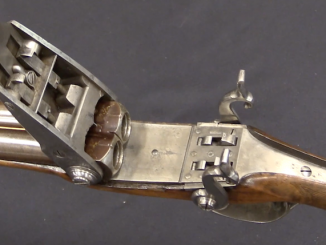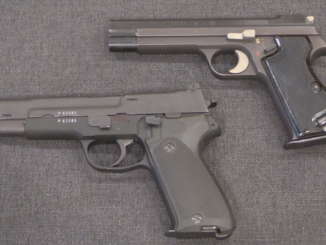The Swiss were one of the first countries to test Hiram Maxim’s new automatic machine gun in 1887, and they found it far superior to their just-recently-purchased Gardner guns. The first Swiss maxims were delivered in 1889, and the country came back three more times for newer models. The MG94 was the first major adoption, followed by the MG00 for cavalry. Finally, after the Maxim patents expired and DWM introduced their improved 1909 commercial pattern, the Swiss adopted it as the MG11. The first 167 MG11s were produced by DWM, but deliveries ceased in 1915 because of the war. This prompted the Swiss National Assembly to order the government arsenal W.F. Bern to begin production, and between 1915 and 1946 the Swiss made 10,269 more MG11s domestically. They were absolutely beautifully made weapons.
In 1934/35, a modernization program made a number of improvements to the guns. The booster was simplified, the trigger was made one-hand friendly (so the second hand could be used to adjust aim while firing), a bracket for antiaircraft sights was added, and traverse and elevation stops were added to the tripods. Most significantly, the cloth belt was replaced by a fully metal belt. That belt is widely regarded as the best Maxim belt ever produced, and it is particularly valuable to shooters today, as it will function with essentially any caliber in any model of Maxim.
Swiss Maxims were never exported in quantity, and they are quite rare today.




A Maxim gun made by the people who brought you the Rolex watch. What’s not to like?
“(…)They were absolutely beautifully made weapons.”
And also durable, as according to https://en.topwar.ru/101566-maksimy-dlya-shveycarii-pulemet-mg11.html
MG51 machine gun was soon created, designed to replace all outdated samples. New weapons were put into service in the 1951 year, and soon the army began to receive serial products. However, the replacement of old weapons with a new one was seriously delayed. Due to the limited capabilities of the factory, the W + F machine guns LMG25 could only be decommissioned in the seventies, and the last MG11 were written off only in the early eighties. thus resulting in 7 decades of services for MG11.
https://de.wikipedia.org/wiki/Mg_11 claims that
Mg 11 (Revisionen 1934/35)…Diese Mg sind am schwarzen Kühlmantel mit einem weissen Strich in Längsrichtung erkennbar.
if it is actually so white strip is for identification purposes (indicating that this particular gun is not older version) not for aiming.
The swiss army regulations “Technisches Reglement Nr. T 3 d, Das schwere Maschinengewehr (Mg. 11)” from 1943 specifies “Der weisse Strich auf dem Mantel erlaubt die flüchtige Kontrolle der allgemeinen Schussrichtung des Gewehrs.” so basically “The white line on the mantlet allows a quick check of the general firing direction of the rifle.” I think the Wikipedia article only refers to the fact that the white stripe was only added when the MG11 were updated to the Revisionen 1934/35 standards.
Hi folks, I’m currently doing a deep dive into the Swiss military archives and have come across references to the ‘Forbes Gun’ which was a mechanical machine gun offered to the Swiss in 1893. They were not really interested but still tested at least one to compare against their Gardner guns. Has anyone ever heard of this thing?
“(…)Forbes(…)”
I did cursory search for fire-arms-related patent for that name and in that or nearby period. I found 2 such patents by William Dunderdale Forbes
https://patents.google.com/patent/CA39154A/fr Canadian patent for Arme a feu granted 1892 details unknown
https://patents.google.com/patent/GB129253A British patent for Improvement in Machine Guns. together with Thomas William Mckenzie published 1920 Relates to long-recoil boltaction guns of the’ kind in which the barrel, breech-bolt, and bolt operating-sleeve recoil together, the return of the barrel to firing position releasing the bolt, and the return of the bolt releasing the operating-sleeve.
Hi Daweo, Thanks for that. For some reason my initial patent search on Espacenet didn’t find anything relevant but using the Canadian patent number you found brings up the original patent drawings of what is a very complicated mechanical contrivance. That has to be the gun offered to the Swiss. They never had any real intention of buying it – but the army was a thorough organisation. In February 1893 they wrote: ‘We currently possess a Gardner gun and have conducted significant tests with it on behalf of the cavalry. After careful consideration, both the fortress artillery and cavalry have opted for the Maxim gun. We believe that Conducting tests with a machine gun similar to the non-adopted Gardner gun in order to compare them.’